
The European market potential for LGBTQ+ tourism
Inclusivity, safety and a welcoming environment are the main principles of LGBTQ+ tourism. The market for LGBTQ+ tourism is one of the fastest-growing, and there are many countries where the LGBTQ+ community is accepted and welcome. Western Europe has a large LGBTQ+ population, which is increasingly confident about travel as they enjoy progressive rights as citizens. But they are careful about where they go, as they understand that not every destination is gay-friendly. Inclusivity, diversity and authenticity are key trends in the LGBTQ+ market.
Contents of this page
1. Product description
The LGBTQ+ initialism (or acronym) stands for lesbian, gay, bisexual, transgender, queer or questioning. ‘+’ refers to other identities that associate with this community, like intersex, asexual, pansexual and many more.
LGBTQ+ tourism covers travel products and services aimed at and designed exclusively for this target market, such as honeymoons and wedding ceremonies for same-sex couples; multi-day, day, or part-day tours; and dedicated accommodations. LGBTQ+ products for family markets are less focused on these travellers but on the family as a whole.
The main principle behind LGBTQ+ tourism is about creating a safe and welcoming environment for this cohort, being inclusive, and communicating with them respectfully.
Figure 1: The LGBTQ+ Initialism
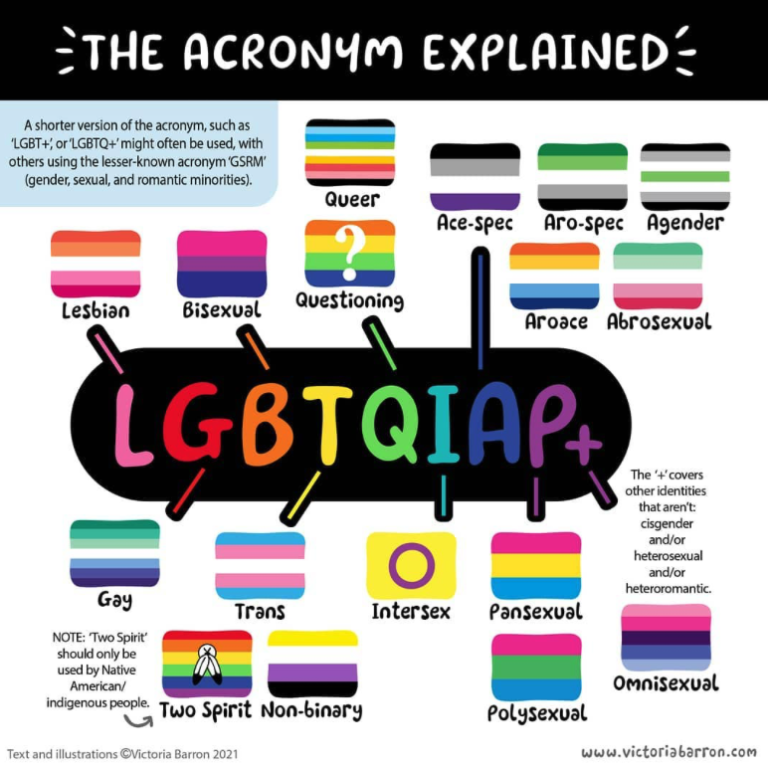
Source: Victoria Barron, 2021
The market for LGBTQ+ tourism has grown over recent years, as more destinations recognise the importance and value of welcoming the community. It is one of the fastest-growing markets internationally because of increased levels of acceptance and rising numbers, especially from younger generations. The market for LGBTQ+ tourists is a substantial one, and in 2016 United Nations Tourism (UN Tourism, formerly UNWTO) stated that 5% to 10% of global tourists identify as LGBTQ+. In addition, UN Tourism stated they travel more and spend more than average tourists, making the ‘pink pound’ valuable to many destinations.
The LGBTQ+ community is widely accepted and respected in much of Europe, from the Scandinavian countries to Malta. Beyond Europe, Canada, Uruguay, Brazil and Australia are well-known as gay-friendly. Elsewhere progress is being made, notably in South Africa, India and several Latin American countries. But this is not the case everywhere.
In 71 countries worldwide homosexuality is illegal and, in some cases, can lead to the death penalty or life imprisonment. This is mostly in the Middle East, Africa and Asia. In much of Africa there is low acceptance of homosexuality – 10 years or life imprisonment is common on the continent, including in Kenya and Tanzania. In Uganda, tougher laws were introduced in May 2023 that included life imprisonment for aggravated homosexuality.
There are also regional differences. For instance, Brazil is one of most progressive countries for gay rights: large cities like Rio de Janeiro and Sao Paulo are very welcoming to the LGBTQ+ community, and the market enjoys many rights. But outside the main tourist destinations, particularly in remote areas, there can be less tolerance and understanding, regardless of the rights of the community.
Figure 2: LGBTQ+ Rights in Brazil
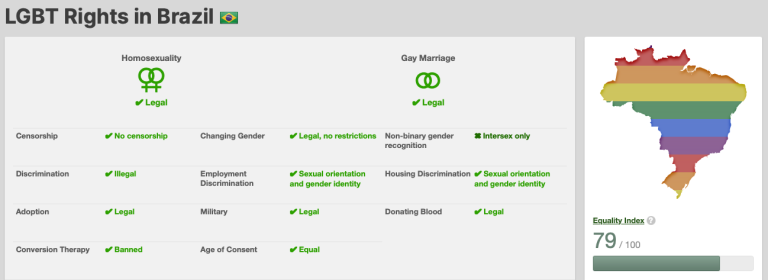
Source: Equaldex, 2024
Use Equaldex to find out more about LGBTQ+ rights in different countries, including yours, around the world.
Examples of LGBTQ+ experiences
LGBTQ+ travel products and services are similar to those offered to other tourists. Most products are exclusively marketed to this target group. They are usually provided by operators who belong to or are very supportive of the community. The LGBTQ+ community wants to be accepted and respected at all times, and travelling with like-minded people is important to them. This target market looks for companies that understand their needs, including where they can safely travel to.
Day and part-day experiences are often centred around the history of local LGBTQ activism. In some marketing materials this is referred to as ‘queerstory’. Multi-trip tours marketed to the LGBTQ+ community usually follow itineraries popular amongst average tourists but guided by an LBGTQ+ guide, and might include gay-friendly accommodations.
Table 1: Examples of travel products aimed at LGBTQ+ travellers
| Trip | Details |
| LGBT Best Highlights in Peru in 11 days | A multi-day trip to discover Perú’s Inca treasures, gastronomic delights and rich cultural heritage, led by LGBTQ experts. |
| Forts and Palaces of Rajasthan – Classic Gay Group | A 15-day trip to the best of the imperial state of India of Rajasthan – Bikaner, Jaisalmer, Jodhpur, Udaipur, Jaipur and the Taj Mahal. Accommodations are in gay-friendly hotels and the trip is accompanied at all times by an experienced gay tour manager.
|
| Queerstory LGBTQ2IA Walking Tour, Montreal | A walking tour to explore LGTBQ+ history through true stories. Participants learn about women’s liberation and gay rights, activism, partying, sex, drugs and police violence. |
Complete Argentina Gay Tour – Buenos Aires, Iguazu Falls, Pagatonia | A 14-day trip to discover the gay scene in Argentina, one of the most gay-friendly destinations in Latin America. Tour includes many fun stops, particularly in Buenos Aires. |
| Gay Group Safaris, South Africa | Discover South Africa with your gay group travel inner circle, tailor-made by LGTBQ experts. |
| Galapagos Gay Cruise, Ecuador | A tour for gay men, friends and family. Although most travellers are gay men, all genders are welcome regardless of sexual orientation. Tour includes a US$50 Rainbow Railroad donation to help resettle LGBTQ+ refugees. |
| Thailand, Vietnam and Cambodia Lesbian Holiday | A 14-day trip covering the highlights of the three destinations, blending cultural immersion, relaxation and exploration for lesbian and queer women. |
Berlin’s Queer and Trans History – a guided augmented reality tour | This tour is led by a queer activist, certified social scientist and sex educator. The tour includes use of an iPad to see sights in augmented reality (AR). AR creates a computer-generated view of what things used to look like, or could look like in the future. Participants can also take selfies that include an element of AR. |
Packages and services designed especially to meet the needs and expectations of the LGBTQ+ community. | |
| Men Only Hotels | Accommodations with facilities designed exclusively for men. |
| Explore the Queer Side of Buenos Aires | This tour explores the history of Argentina’s LGBTQ+ history. It is guided by members of the local community; this tour supports a school for trans and gender non-conforming residents. |
Source: Acorn Tourism Consulting, 2024
End-market segmentation and consumer behaviour
The LGBTQ+ segment is a small but growing niche. Currently, the percentage of the global population that identifies as LGBTQ+ is around 9%. It is growing as they feel more accepted and open, and because there are more members from younger generations openly identifying as LGBTQ+. In 2022 in the US, for instance, the LGBTQ+ community was estimated to be 7.1% of the population with one in five Gen Z identifying as LGBTQ+.
The LGBTQ+ segment is comprised of several groups of people, broadly identified as follows:
- Lesbian: Lesbian travellers often identify as women first. This means that safety while travelling is important to them as women. Cultural attitudes towards women and modes of dress expected of women in a destination affects where they choose to travel. Lesbian travellers seek good value experiences and often prefer to travel independently. UN Tourism estimates that lesbians and bisexual women account for 46% of the LGBTQ+ community.
- Gay: Male gay travellers often prefer to visit urban destinations that are gay-friendly, like Rio de Janeiro and Amsterdam. They are more interested in gay events, festivals and nightlife. They like to meet locals and other like-minded gay men when travelling. It is estimated that gay men and bisexual men also account for 46% of the LGBTQ+ community.
- Transgender: In recent years there has been increased visibility of issues faced by transgender people in Europe. When it comes to travel, transgender travellers value most of all a welcoming environment where they are respected. It is estimated that transgender people represent about 8% of the LGBTQ+ community.
- Bisexual: Bisexuals relate to both men and women and do not want to be labelled as gay or straight. Who they travel with at the time impacts they way they feel, so flexibility around this group is key.
- Queer or questioning: This segment includes many other smaller niche segments such as intersex and pansexual.
- +: All other identities that associate with the community. These include but are not limited to pansexual, asexual, non-binary, intersex, and many more.
- LGBTQ+ families: This segment includes parents of children who have been adopted, are from previous relationships or were fostered, or were born from donor insemination or surrogacy. Same-sex parents of adopted children are the most common group in this segment.
Source: Second Global Report on LGBT Tourism, UN Tourism, 2017
It is important to realise that the LGBTQ+ community is extremely diverse. Some may be happy to identify openly as lesbian, gay, bisexual or transgender; others are not. There is evidence that these traditional labels used to categorise LGBTQ+ are becoming less relevant, owing to changing social attitudes.
This market crosses all ages, life stages, socio-economic factors, family groups and many others. The travel motivations of the different groups within the LGBTQ+ segment vary widely. For instance, gay men are more likely to travel to city destinations that have gay events and nightlife. Lesbian travellers are more likely to take a trip that includes rural tourism activities. LGBTQ+ families are more likely to choose a destination offering child-friendly activities.
There is also some difference between older and younger generations. Baby boomers (born between 1946 and 1964, aged 59-78 in 2024) are likely to have faced more discrimination during their lives and may not be so open about their sexuality or their travel needs.
Figure 4: Young LGBTQ+ people demand respect and inclusivity
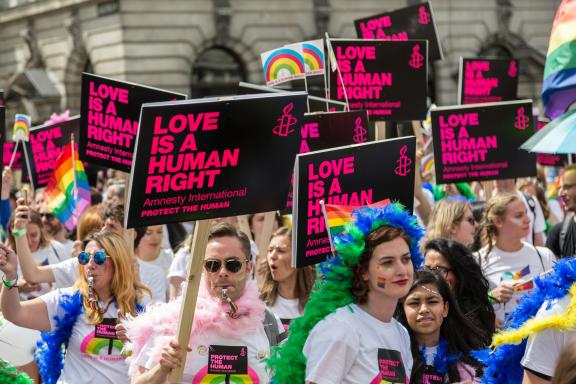
Source: Ian Taylor at Unsplash
By contrast, younger consumer groups like Gen Y (born between 1980 and 1995, aged 29-44 in 2024) tend to be more open about their sexuality and demand respect and inclusivity. They are more likely to seek specific products and services and travel more openly. They expect a high level of service from tour operators and other service providers – personalisation is important to them. The outspoken nature of this group is leading the way towards helping change social attitudes and public perceptions of LGBTQ+.
Social media and digital platforms play a significant role in the lives of LGBTQ+ people, as with many other target groups. This is particularly the case amongst the younger generations. The group often relies on social media and review sites to research destinations, accommodations, and activities before booking.
Travelling is still challenging for LBGTQ+ but there are positive signs
Although there has been good progress in establishing rights for LGBTQ+ people, they still face discrimination and intolerance in their travels. Research conducted by Booking.com in 2022 found that 82% of LGBTQ+ people experience less-than-welcoming or uncomfortable experiences when travelling, with 64% reporting they have to consider their safety and well-being. The most negative experiences reported were when they were out in public (31%.) Over half (51%) felt that destinations on their ‘bucket list’ had been affected by being part of the LGBTQ+ community. Other findings included:
- More than half (55%) experienced discrimination when travelling.
- 28% were subjected to stereotyping.
- 18% were stared at, laughed at or verbally abused by other travellers.
- 17% were subjected to the same by local people.
However, there are good signs that LGBTQ+ people are also having positive experiences; 85% of travellers also reported that most of their travel experiences have been welcoming. Amongst gay and lesbians, this figure rises to 90%. Connecting and celebrating local LGBTQ+ communities is the most important factor for LGBTQ+ travellers, along with specially tailored products:
- 60% of LGBTQ+ travellers are more likely to choose a destination that celebrates its local LGBTQ+ community and history.
- Over half (56%) are more likely to choose a destination where they can learn about local LGBTQ+ lives.
- 55% are most likely to look for activities and attractions tailored for the LGBTQ+ community.
- 55% research experiences and brands before booking, to understand how these connect with the LGBTQ+ community.
- A further 64% are more likely to book with a brand that makes efforts in this direction.
- 37% would like to have more recommendations tailored to their preferences and interests.
- 31% would like more information about the destination and whether it is LGBTQ+-friendly, including local laws, religious sensibilities, what clothes to wear, and even hate crime statistics.
As inclusive tourism for all continues to grow, LGBTQ tourism will expand to new destinations. However, until LGBTQ consumers are free from discrimination in society, demand amongst the LGBTQ+ community will continue to be for travel to destinations that can offer a safe and welcoming environment.
Accessible tourism on the European market
Accessible tourism is the ongoing endeavour to ensure tourist destinations, products and services are accessible to all people, regardless of physical limitations, disabilities or age. It encompasses publicly and privately owned tourist locations. The improvements not only benefit those with permanent physical disabilities, but also parents with small children, elderly travellers, people with temporary injuries such as a broken leg, as well as their travel companions. Disabled tourists may travel individually, in groups, with their family or with carers.
Accessibility and LGBTQ+ tourism
LGBTQ+ travellers with disabilities feel they have more to contend with when they travel compared to average tourists with disabilities. They will do a lot of research before they travel, to make sure they are visiting a safe destination and that the services they choose can meet their needs.
Many practical needs are similar to those of other target groups, like suitable signage, accessible seats, handrails, disabled toilets, suitable accommodations, braille menus/guides and wheelchair accessibility. For the LGBTQ+ community, gender-neutral toilets give reassurance they are in a safe space.
Build your knowledge of the issues surrounding LGBTQ+ and disabilities. Read this blog by a transgender, queer and disabled traveller for an insight into the issues they face when travelling. The blog It’s time to make all queer spaces accessible provides information about sensory disabilities.
Tip:
- Read the CBI studies The European market potential for accessible tourism, and Entering the European market for accessible tourism products for practical and useful advice to make your tours accessible.
2. What makes Europe an interesting market for LGBTQ+ tourism?
Europe is an interesting market to target for LGBTQ+ tourism, as it is estimated that 5.9% of Europeans self-identify as LGBTQ+. However, that number could be much larger, as over 10% of Europeans also identify as ‘not only heterosexual’. The market has a high concentration in the 25-44 age group, while the 18-24 age group grows every year.
This travel group are big spenders. The global spending power of LGBTQ+ was estimated to be US$4.7 trillion in 2022 and is growing. The market is expected to surpass US$610 billion by 2032. Potential GDP (gross domestic product) impact of inbound LGBTQ+ tourism and travel is estimated to be more than 1% for a few countries, like Thailand, Portugal, Greece and Hong Kong.
Growth in LGBTQ+ travel is being driven by increasing societal acceptance of LGBTQ+ people and the rise in purchasing power. They tend to have greater disposable income than many other target groups. They spend more per day and can travel outside of peak season. Challenges to growth include a lack of LGBTQ+-friendly infrastructure in many destinations, as well as the potential for discrimination and hate crimes. This is particularly true in destinations where being gay is illegal.
Western Europe is one of the most progressive regions for LGBTQ+ communities. It home to some of the most gay-friendly cities in the world, including Amsterdam, Berlin and Madrid. Many European countries have granted the same rights to LGBTQ+ as other citizens, such as the rights to marry and adopt children. During Pride month each June, numerous European cities show their support for their LGBTQ+ communities, hosting large Pride festivals and flying Pride flags.
This means that European LGBTQ+ have become increasingly confident to be themselves and are keen to travel. But they will carefully choose where to go, as they understand that not every destination is gay-friendly.
3. Which European countries offer the most opportunities for LGBTQ+ tourism?
The European countries that offer the most opportunities for LGBTQ+ tourism in developing destinations are those with the largest LGBTQ+ populations. These are Germany, the UK, France, Spain, Italy and the Netherlands. In all source countries discrimination based on sexual orientation and gender identity is prohibited by law.
Tips:
- Find out how friendly your country is towards LGBTQ+ travellers. You can check Equaldex to see how your destination compares with neighbouring countries.
- Follow your national and local news for any new laws or instances of discrimination or intolerance against LGBTQ+ people so you can get a big picture of the situation for LGBTQ+ residents.
Figure 5: LGBTQ+ populations in Europe
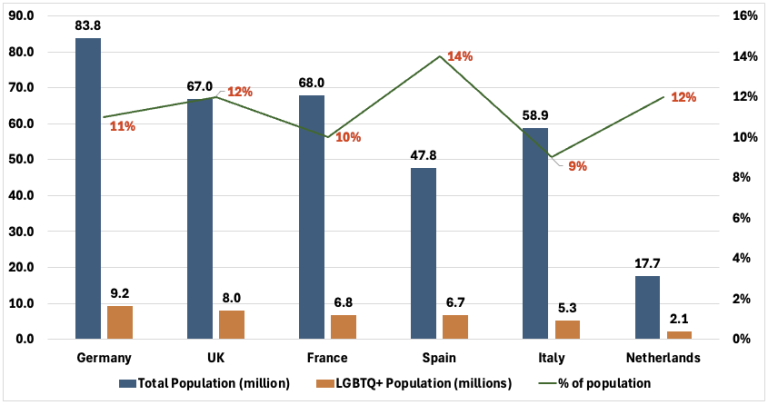
Source: Acorn Tourism Consulting, LGBT+ Pride 2023, Ipsos
Western European LGBTQ+ individuals are known to travel to more long-haul destinations than those from Eastern Europe. As they tend to be more confident and knowledgeable about the issues they face, they do extensive research into local attitudes, laws and safety in the destinations they plan to visit. By contrast, LGBTQ+ persons from Eastern Europe are more likely to visit destinations that are widely known to be safe, mostly in Europe.
Growth across all main source markets is expected to continue in the coming years. This will be driven by an increasing demand for LGBTQ+-friendly destinations and experiences, and more of this cohort seeking LGBTQ+-friendly travel options. This offers good opportunities to local tour operators that can meet the demands of this valuable market.
To attract this travel group, you will need to be very clear that your destination welcomes the LGBTQ+ community, and that they will be safe. Tolerance and acceptance is extremely important to them, and they will not travel to your destination or take your tour if you cannot guarantee this to them. Europe is the top destination for all LGBTQ+ travellers, as they can generally be assured they will be able to travel easily and safely there.
However, international destinations are increasingly part of tour operator itineraries, showing how the market wants to travel further afield when possible.
Germany
Germany has the largest LGBTQ+ population in Europe: 14% of its population of 83.8 million identify as LGBTQ+ (around 9.2 million). This represents a very large and diverse number of potential travellers to target with gay-friendly travel products. It ranked 8th on the Gay Travel Index 2024, a worldwide country ranking that looks at 18 different factors, including anti-discrimination laws, marriage equality, Pride parade bans and the death penalty.
Germany legalised same-sex registered partnerships in 2001. Same-sex marriage was legalised in 2017, allowing LGBTQ+ couples to marry and adopt children. There are various Pride events hosted in German cities, including Berlin (one of the largest in Europe), Cologne, Hamburg and Munich. In tourism, Berlin has established a set of standards for the hospitality sector to welcome LGBTQ+ guests known as the Pink Pillow Berlin Collection.
German LGBTQ+ are likely to research the internet widely for travel advice. They will read blogs like Holiday with Olaf, which provides links to other gay influencer websites, both German and from around the world. There is also MisterB&B and Queerio!, a gay lifestyle website. This market will also use tour operator websites that are either LGBTQ+-managed or are openly supportive of the community: examples are Kerle Reisen, which offers group travel for gay people, and Pink Tours, which has different sections for lesbian and gay holidays.
Popular travel destinations for the German LGBTQ+ community include South Africa, Mauritius and Indonesia. Some tour operators even offer tours to Kyrgyzstan, suggesting that German LGBTQ+ may be prepared to travel to more off the beaten track if it feels safe. The blog Gay Travel Index – the LGBTQ+-friendly destinations provides useful advice for this market on the safest travel destinations, which beyond Europe include Uruguay (8th place), Chile and Colombia (13th place), and Argentina and Réunion (21st place). This market is likely to consult such sources to help in their decision-making.
Figure 6: Seeking advice from LGBTQ+ travel bloggers is common amongst this target group
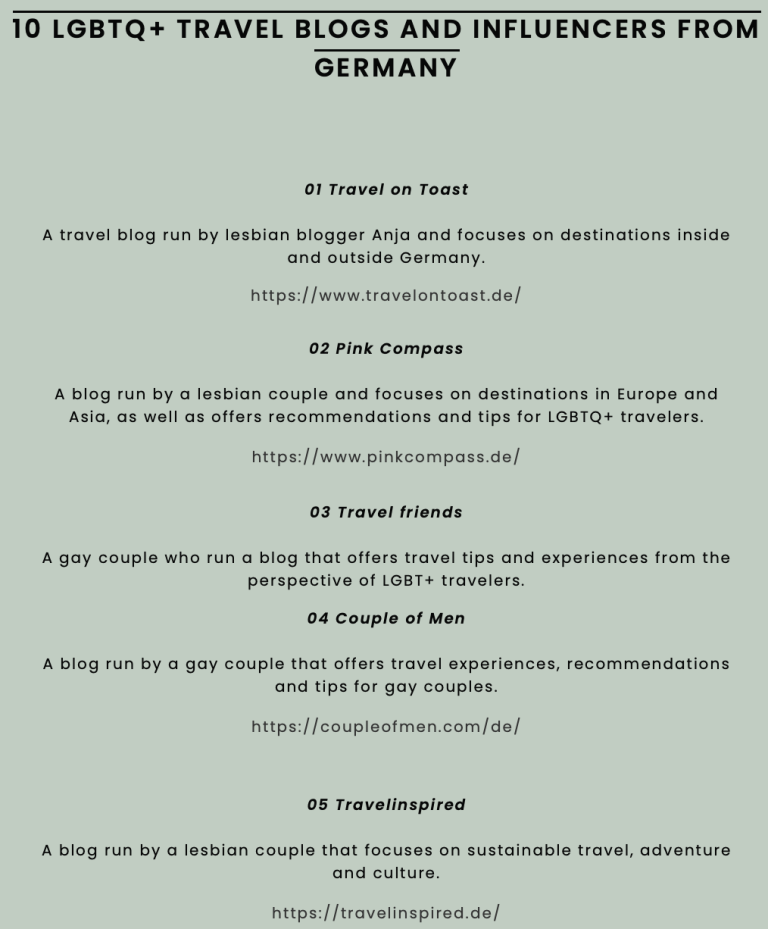
Source: Holiday with Olaf, 2024
United Kingdom (UK)
The UK has the second-largest LGBTQ+ population in Europe; 12% identify identifies as LGBTQ+ (about 8 million). However, it ranked 21st on the Gay Travel Index 2024, a downgrade from 9th place in 2023. It has lost points for transgender rights, LGBTQ+ marketing and hostility from locals.
Still, the UK has made significant progress in terms of legal rights and protections for LGBTQ+ people. Same-sex marriage was legalised in 2014 and there are many LGBTQ+ organisations and advocacy groups operating in the country. Research has found that UK citizens are amongst the most supportive of children, siblings or close family members who come out as gay (79%) compared to other source markets.
The target group in the UK uses the internet extensively to find advice and make decisions about where to travel. Some of the top gay influencers in the UK include Sion & Ben, the Globetrotter Guys, a married couple who have visited more than 70 countries and provide valuable insights into LGBTQ+ travel. Jenna & Kirsten write the Jenna Way blog, sharing their adventures in a van.
There are many LGBTQ+ tour operators on the British market: Out of Office[TC-VU1] is a leading gay travel agency specialising in luxury travel worldwide. Gaily Tour[TC-VU2] offers holidays all over the world by theme – city breaks, cruises, weddings, and so on.
France
France has an LGBTQ+ population of around 6.8 million, accounting for 10% of the total population. It was ranked 21st on the Gay Travel Index 2024. France has made good progress in advancing LGBTQ+ rights and legal protections. Same-sex marriage was legalised in 2013. The Paris Pride Parade (Marche des Fiertés) is the largest parade in France. Many major cities, including Paris, Lyon, Marseille and Toulouse, have vibrant LGBTQ+ neighbourhoods and community spaces.
Like the other markets, French LGBTQ+ use the internet widely to research their holidays. Bloggers and influencers are a source of information. Proud and Gay outlines the criteria it uses to make recommendations to its clients. Outside Europe, the operator identified Sydney (Australia), Bangkok (Thailand), Tel Aviv (Israel), Toronto (Canada), and San Francisco (USA) as the top destinations, based on these criteria.
Figure 7: Selecting destinations for the French market
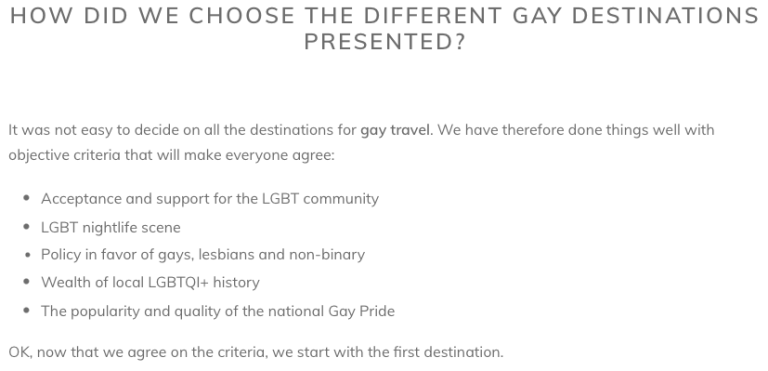
Source: Proud and Gay, 2024
La Perle Noire features Thailand prominently on its LGBTQ+ homepage, suggesting the country is a popular destination for the French market.
Spain
Spain has the largest proportion of LGBTQ+ in its population, representing 14% of the adult population (around 6.7 million). It ranked top on the Gay Travel Index 2024, which shows the strong gay friendliness in the country plus a high level of confidence amongst Spanish LGBTQ+.
The LGBTQ+ community in Spain is diverse, resilient and active in advocating for equality and acceptance. It is known for its progressive LGBTQ rights legislation – same-sex marriage has been legal since 2005. Pride celebrations in Spain are some of the largest and most colourful: Madrid Pride, or MADO, is one of the biggest Pride events in the world, attracting millions of visitors. Spanish citizens are the most supportive of children, siblings or close family members who come out as gay (81%) compared to other source markets.
The Spanish market looks for advice and information on the internet, and may consult sites like Every, an LGBTQ+ lifestyle blog that includes travel. Deaquíparallí with Iván and Javier is another travel influencer website.
The Queer Travel mostly promotes Spain but also highlights Vietnam as a good LGBTQ+ destination. It is a good idea to see which destinations are profiled by LGBTQ+ tour operators, as they generally will have done their research on behalf of the community.
Italy
Italy has an LGBTQ+ population of around 5.3 million, accounting for about 9% of the total population. It ranked 58th on the Gay Travel Index 2024, much lower than the other source markets, suggesting that LGBTQ+ people feel more discriminated against in Italy than in other European countries.
There are several Italian gay bloggers, including Gnambox, which has almost 180,000 followers on Instagram. It was created by Riccardo and Stefano, who cook and travel. Others are Gayly Planet and the Globbers, who also provide group trips and tailor-made travel to destinations as diverse as Morocco, Japan, India, South Africa and Namibia.
Europe is the most popular region for Italian LGBTQ+ travel. Destinations beyond Europe may include Israel, Cuba, South Africa and Mexico.
The Netherlands
The Netherlands has a long history of LGBTQ rights and is one of the most LGBTQ+-friendly countries. Amsterdam Pride is one of the most famous and well-attended Pride festivals in the world. Many other cities and towns throughout the Netherlands also host their own Pride events, parades and festivals. It was the first country to legalise same-sex marriage, in 2001.
With 12% of its population identifying as LGBTQ+ (around 2.1 million), it ranked 21st on the Gay Travel Index 2024. The index gets wide publicity in the country, and the press noted that the country had fallen by one place. With this sort of coverage, it is likely that the Dutch LGBTQ+ community consults the index to identify safe places to visit.
Bloggers like Linda are sources of information for the Dutch community. In this blog you can also see where the worst places for LGTBQ+ travel are, such as Saudia Arabia, Iran and Malawi.
Tips:
- Do your own internet research to find influencers and tour operators in each country that focus on the LGBTQ+ market. That way, you can find out more about each of the source markets. Be sure to also look at their social media platforms for additional information. Instagram is the most widely used.
- Be inclusive and informative to connect with this community. These actions will help you attract this group of travellers.
- To find more information about the market, research LGBTQ+ organisations in Europe like ILGA-Europe and The International LGBTQ+ Travel Association (IGLTA). If you become a member and include their logos on your website, it will be clear signal that your business is LGBTQ+-friendly.
- Find out more about pro-LGBTQ+ law in European countries via the interactive website Rainbow Europe.
4. Which trends offer opportunities or pose threats in the European LGBTQ+ market?
LGBTQ+ travel continues to evolve, driven by higher numbers in the younger generations, changing attitudes in society and technological developments. Emerging destinations are recognising the importance of the pink pound, and Pride events are more common around the world. The LGBTQ+ group is increasingly visible in tourism niches such as family travel and weddings and honeymoons.
Emerging destinations attract LGBTQ+ travellers
Traditional LGBTQ+ hotspots in developing countries like Brazil (Rio de Janeiro) and Argentina (Buenos Aires) continue to draw large numbers of LGBTQ+ visitors. But emerging destinations are also gaining attention. Latin American and Asian countries are increasingly catering to LGBTQ+ tourists, offering unique cultural experiences and LGBTQ+-friendly amenities. South Africa is fast becoming a hotspot for LGBTQ+ tourism in Africa. The best emerging destinations are Uruguay, Mexico, Thailand, South Korea, the Philippines, Vietnam and South Africa.
However, it can still be difficult for LGBTQ+ to travel to countries like these. Tolerance and acceptance are often higher in large cities but things can be very different in more rural and remote areas. These factors pose a threat to a wider development of this niche beyond Europe. To mitigate against this, and as a local tour operator working in emerging destinations, it is important to understand the situation fully so you can support LGBTQ+ visitors and provide a welcoming experience.
In spite of this, there is evidence that LGBTQ+ individuals are choosing to travel to no-go destinations anyway, on ‘rainbow rebellions’. They want to travel to bucket-list destinations like the Maldives, Egypt and Kenya, and experience what other people enjoy too. Many LGBTQ+ people feel they must protect their true identity in certain situations anyway, and are prepared to disregard strict anti-LGBTQ+ legislation for a bucket-list experience.
Social media influencers like gay YouTubers Oskar and Dan are helping drive this trend. Oskar and Dan filmed their trips together to off-limits destinations, including Saudi Arabia, Kuwait, Morocco, Uganda and Brunei. LGBTQ+ TOUR operators are catering to the rising demand for such destinations. Out Adventures and Out of Office are two such examples. Risk-taking ‘rainbow rebels’ are the most likely segment for rainbow rebellions – typically younger solo or couple travellers with reasonably high budgets.
Gen Z LGBTQ+ segment growing
2024 research conducted in the USA has found that the numbers of Gen-Z LGBTQ+ have risen further and faster since 2022 and are now as high as 28% of the population. These figures are likely to continue climbing as more young people become adults and global acceptance of the community continues to grow. This presents great opportunities for providers to target this group. Gen Z are known to be the most tolerant of all consumer groups. They also have the most desire to travel.
Read more about the Gen-Z group in the CBI study What are the opportunities on the European Gen Z tourism market.
LGBTQ+ demand sustainability in travel
Like other tourists, LGBTQ+ travellers also value sustainability and responsible travel practices. Sustainably managed accommodation and LGBTQ+-owned businesses are gaining popularity and visibility. LGBTQ+ holidaymakers also look for diverse and authentic travel experiences beyond traditional nightlife and party scenes. Cultural immersion, adventure travel, culinary activities and wellness retreats are becoming more popular amongst a target group looking for meaningful and enriching experiences.
Sustainability in LGBTQ+ tourism also involves promoting and practicing equality and inclusivity for all. The United Nations Sustainable Development Goals (SDGs) to end poverty and inequality by 2030 were signed on the basis that they applied to everyone, everywhere, and ‘leave no one behind’. LGBTQ+ activists recognise the potential of using the SDGs to help advance equality.
The Sustainable Development Goals and LGBT Inclusion by the UK-based charity Stonewall is a resource showing some of the ways equality can be achieved through the SDGs. As a local operator, this guide will be useful for you to embed equality as you establish your business.
Increased LGBTQ+ visibility across many tourism niches
Family travel and weddings and honeymoons are amongst the top tourism niches for this target group. Being able to cater to the needs of the LBGTQ+ market offers good opportunities for local tour operators that can meet their needs.
- Family travel: Since same-sex marriage and adoption is legal throughout most of western Europe, the numbers of ‘rainbow families’ have grown. In the UK, there are 40% more same-sex families than in 2015. As a result, holidays by LGBTQ+ families and multi-generational travel groups continue to be an expanding segment within the market. Destinations are increasingly catering to the needs of LGBTQ+ families, offering family-friendly accommodations, activities and services that are inclusive and supportive.
Local operators should be aware that same-sex families do not necessarily want to do LGBTQ-focussed activities. Holidays with their families are more about the family dynamic, and family-oriented activities are important to them. Make sure you put the emphasis on the family when marketing to this group.
- Weddings and honeymoons: The market for same-sex destination weddings and honeymoons continues to grow as acceptance and recognition of LGBTQ+ rights also grow. Exotic and unique destinations like Bali and Mexico are popular. There has also been an increase in wedding services specialising in LGBTQ+ weddings. They provide expertise to ensure legal requirements are met, and support to ensure the destination can provide a welcoming and inclusive experience.
The wedding and honeymoon segment is a lucrative niche. They are often luxurious and are usually expensive to host, with many guests as well as the couple and their families. There are good opportunities for local operators to provide experiences to this broad range of visitors.
Figure 8: Same-sex weddings and honeymoons: a growth area for LGBTQ+
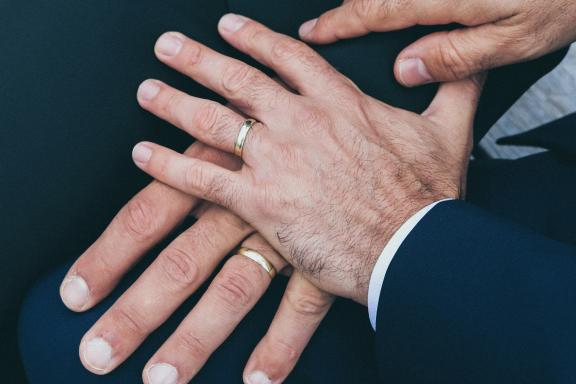
Source: Nick Karvounis at Unsplash
- Pride events: The number and size of Pride events across the world have increased substantially over the past 50 years. See these top events in Latin America and Africa. They can be a rite of passage for many LGBTQ+ people who may not have done much travelling yet. According to Airbnb, hosts earned more than US$77 million during Pride celebrations in 2022. In addition, the number of hosts using LGBTQ+ inclusive language on their listings has grown by 90% since 2017.
- Limelight Gaycations: Aligned with pop-culture tourism, this niche involves travel to places made popular by movies, TV, books and music. It is particularly relevant right now as there quite a few shows featuring positive LGBTQ+ content, like the Oscar-nominated film ‘Call Me By Your Name’. Another example is the series White Lotus, filmed in Hawaii and Sicily. Interest in both destinations surged after the show was aired: the third season is scheduled to be filmed in Thailand, a top LGBTQ+-friendly destination.
Technology developments: Gay-I interfaces
Smooth travel enabled through technological developments is becoming an essential component for all travellers today. Automated check-ins are very common now and are also useful to help support the LGBTQ+ community. For instance, the transgender community can avoid uncomfortable assumptions when documentation is checked via self-check kiosks at hotels, airports and borders. The international hotel chain Yotel has introduced automated check-in kiosks at all its hotels.
With artificial intelligence (AI) being applied more widely across the sector, the LGBTQ+ community will likely benefit from extra peace of mind when travelling. By analysing real-time data, AI systems will be able to identify areas of risk and potential threats of discrimination, provide alerts and make recommendations. Virtual LGBTQ+ platforms will be able connect travellers, make personalised suggestions, provide translations, and enable communication with tour operators and guides.
Tips:
- Use Pride or other gay events to attract customers by marketing tours before, during and after the event. This will provide you with opportunities to make sales and spread the word that you are a gay-friendly business.
- Use LGBTQ+ inclusive language on your website. For instance, use ‘partner’ instead of ‘girlfriend’ or ‘boyfriend’. Check your website for inclusiveness and see where you should make changes. This is essential to attract the European market.
- Make sure your tourism business is sustainable. The CBI study How to be a sustainable tourism business can help.
Acorn Tourism Consulting Limited carried out this study on behalf of CBI.
Please review our market information disclaimer.
Search
Enter search terms to find market research
